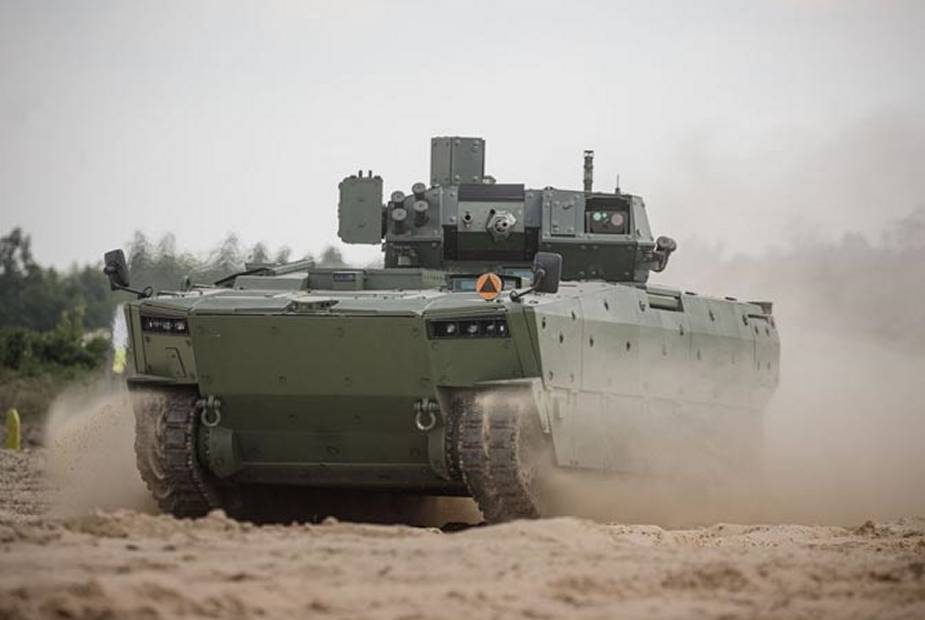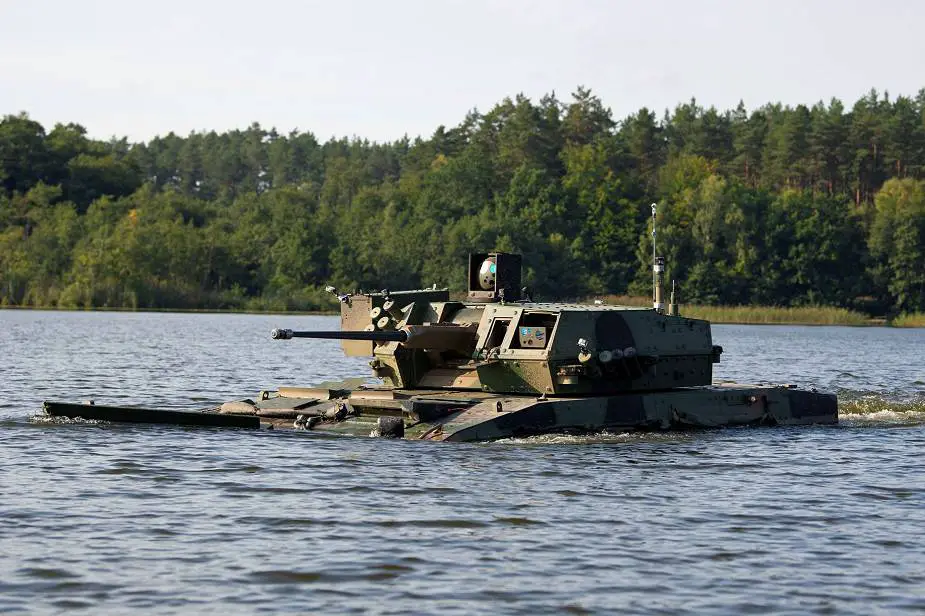The Slovak Ministry of Defense received four bids in the process of acquiring new infantry fighting vehicles (BVP) for the ground forces of the Armed Forces of the Slovak Republic. A big surprise is the offer of BVP Borsuk from the Polish industry, Armadny Noviny writes.
Follow Army Recognition on Google News at this link

The Borsuk IFV was presented as part of the "Dragon '21" exercise, the first maneuvers of the Polish Army (Picture source: Polska Grupa Zbrojeniowa)
As recalled by Armadny Noviny, the project of the New Amphibious Combat Vehicle of the NPBWP (Nowy Bojowy Pływający Wóz Piechoty) Borsuk is implemented by a consortium led by HSW (Huta Stalowa Wola), Armadny Noviny writes. The Borsuk program was scheduled to begin in 2013, but competition No. 4/2013 announced by the National Center for Research and Development (NCBiR) was canceled. The decision was made only after competition No. 5/2014, which enabled the signing of a contract for research and development work with a budget of PLN 75 million on October 24, 2014 (PLN 82 million at today's prices; CZK 438 million).
In 2016, research and development work reached the second phase, ie the creation of a conceptual design and technical and economic analysis. Afterwards, the initial tactical and technical assumptions (WZTT) were handed over to the contractor, which enabled the development of a preliminary version of BVP Borsuk in May 2017 and the construction of a demonstrator. This demonstrator, also called a model, was first seen at the construction of MSPO 2017 defense exhibition in Kielce. The basic hull of the demonstrator corresponded in material and shape to later prototypes.
The first real prototype Borsuk was created in 2018 and was equipped with the Polish unmanned combat module ZSSW-30 (Zdalnie Sterowany System Wieżowy). The ZSSW-30 program ran (and is running) independently of the Borsuk program. Prototype tests confirmed its navigability and good traction properties.
Experience with tests of the first prototype enabled the development of the final version of Borsuk, i.e. the second prototype (the third copy of BVP Borsuk). This second prototype is used for further test research and was introduced at the Deba polygon during the Dragon-21 exercise. The previous specimen, the first prototype, as expected at the time of the start of development work on the NBPWP, was used to verify ballistic and mine protection during rigorous testing.
A series of tests began in 2020 - preliminary tests ended in 2021, the end of qualifying is planned for this year. In 2023, the first 14 Borsuk production vehicles will be taken over by the Polish Armed Forces.

BVP introduced Borsuk during the Dragon-21 exercise. This is the "second prototype". The side module is clearly visible, which is probably the biggest puzzle of the construction. The method of mounting the interchangeable modules is also visible. This increased the width of the vehicle to the required 3,400 mm and improved the buoyancy volume for amphibious operations. (Picture source: HSW)
The design of the Borsuk corresponds to typical modern vehicles of this class. In the front, there is an L-shaped engine compartment for a power-pack unit - a German MTU 8V199 TE20 engine with an output of 530 kW (720 hp) (known from the Boxer transporter) and a Perkins X300 automatic transmission.
BVP Borsuk uses hydropneumatic (HP) suspension instead of torsion bars. 12 Horstman InArm suspension modules from the British-German concern Horstman were used. The Horstman InArm suspension is not very widespread in the world, Armadny Noviny writes. The only mass-produced combat vehicle using this particular type of HP suspension is the new Singapore BVP Hunter. This type of HP suspension was designed for canceled projects of the American BVP GCV (Ground Combat Vehicle), and for the British reconnaissance combat vehicle FSCS (Future Scout and Cavalry System).
Detailed information on ballistic protection solutions is confidential, Armadny Noviny underlines. The basic and most important information is that Borsuk mainly uses high-strength armor steel (class 500) in the form of plates with a thickness of 10 mm. This thickness was "calculated" by an enthusiast on a demonstrator presented at MSPO 2017, which was later rebuilt into the first prototype. The hypothesis of the use of steel of this class and thickness is confirmed by the fact that the same steel plates (and the same thickness) are used for the production of Opal III (LPG) vehicles, which occur in the Polish army in the form of artillery command vehicles for howitzers Krab and mortars Rak (all manufactured by HSW). The use of steel grade 500 itself is a solution specific to the Polish defense industry. In the West, steel grade 450 is used to build BVP, which has a better hardness-to-plasticity ratio and is easier to weld.
The MIL-DTL-46100 standard is unambiguous, in accordance with which we can specify the ballistic resistance of a 10-millimeter thick ballistic plate H500. The resistance of the armor is tested at a breakthrough at an angle of 30 °, while the result itself is a minimum impact speed meeting the requirements for 50% of interventions. For a 10mm-thick plate, this speed exceeds the muzzle velocity of the 7.62 mm M2 caliber projectile.
According to the manufacturer, such additional ballistic protection meets the requirements of level 3, i.e. it protects against 7.62 mm piercing ammunition. In reality, however, due to the performance of rifle cartridges with a carbide core, this shield also protects against rifle cartridges of larger calibers. A shield meeting the minimum requirements of level 3 also protects against 12.7 × 99 mm incident hitting at a right angle from 100 meters, and against 14.5 × 114 mm incident at an angle of 30° from a distance of 200 meters. It is known from publicly available studies that in the case of 14.5 mm projectiles, such ballistic protection can be achieved with 50% of hits even when firing from a distance of 100 meters at an angle of 20°. However, given the use of a spatial arrangement where the steel plates are 80mm apart, the actual effectiveness of this armor may be even higher - the above results are possible when the distance between the steel plates is 30 mm.
There may be another thin steel plate in the side module - for example a perforated plate made of high hardness H550 / 600, which can improve the impact resistance and increase the probability of destruction of the projectile during penetration. However, in the case of protection against penetrating ammunition from 23 and 30 mm automatic cannons, the indication of resistance to hits at an angle of at least 60 ° should be used for the time being.

The Borsuk is fully amphibious and propelled by water jets mounted at the rear of the hull (Picture source: Polska Grupa Zbrojeniowa SA)
The currently presented Borsuk is 3,400 mm wide - in accordance with the requirements of the army. However, the originally designed vehicle was 3,200 mm wide. This 200mm difference can give an idea of the overall lateral resistance of BVP Borsuk. In the case of 3UBR6 missiles (30 × 165 mm), there is a real possibility that the Borsuk side armor protects against hits at an angle of 60° at a distance of 500 to 700 meters - which is a typical shooting distance from 20 to 30mm guns, Armadny Noviny writes.
Given the fact that in the "bare" version (i.e. without additional floats), the Borsuk is 3,200 mm wide - which means that it is one of the few BVPs that will fit into the very strict Czech standards for rail freight (maximum vehicle width must be 3,290 mm). At the same time, the maximum width of the vehicle does not limit the installation of additional armor. It is possible to transport much wider vehicles on Polish railways - the width of Borsuk can be 3,550 or even 4,000 millimeters. Railway wagons intended for the transport of heavy military vehicles were designed for the transport of T-72 series tanks, which are 3,550 mm wide and Polish regulations allow the transport of vehicles up to 4,000 meters wide.
The real "bottleneck" of any BVP design is the suspension. The 14 InArm suspension modules were to enable the BVP GCV to reach a maximum combat weight of 76 tons. The same suspension is currently also designed for the BVP M2 Bradley - 10 modules are designed to provide a load capacity of up to 45 tons. The advantage of this type of suspension is that it does not interfere with the design of the hull of the combat vehicle and at the same time, the process of replacing the suspension modules is simpler compared to the process of replacing the torsion bar-based suspension. In addition, the chassis parameters can be changed by selecting the pressure of the compressed nitrogen in the dampers. So there are really no limits to the possibilities of the HP suspension used.
In fact, the only significant limitation in adding additional armor to the BVP Borsuk is the currently used 530 kW MTU engine. However, there is a variant of the same engine with an output of up to 618 kW, which ensures satisfactory mobility for vehicles up to 38 to 40 tons.
A great advantage of Borsuk is that, as a vehicle designed from the ground up in the second decade of the 21st century, it already incorporates advanced solutions (e.g. HP suspension) and concepts (easy-to-replace, customizable modular armor, a powerful power source for sophisticated communication systems) and potential APS installation). Other manufacturers are trying to adapt these solutions to existing designs. BVP Borsuk, therefore, has a large reserve for the development of derived variants and future development.
HSW is a manufacturer of both the vehicle and the ZSSW-30 combat module. This fact allows HSW a highly flexible approach to the possible joint production of vehicles for the Slovak army. A modern turret system costs half, if not more, the price of a whole vehicle. As a vehicle and module manufacturer, HSW can more easily personalize the appearance of the requested BVP according to Slovak requirements than those interested in offering a vehicle and turret from two different manufacturers, Armadny Noviny states. Another option is to leave the choice of combat module to the customer. It is worth mentioning here that, in addition to Borsuk, HSW has to produce modules for Rosomak wheeled vehicles - there are currently 340 of them, Armadny Noviny concludes.















